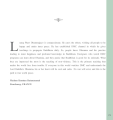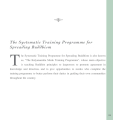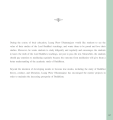Northern Buddhism : ค้นหาหนังสือธรรมะ หน้า 4 / 35
หน้าหนังสือทั้งหมด

103
The Historical Significance of Dhammakāya Verse in Thai Buddhism
Although there is no date on the manuscript, the dhammakāya verse has been known in the Lan Na regions for many centuries. It also appears on a 16th century stone inscription unearthed at the site of
The dhammakāya verse has been recognized in the Lan Na regions for centuries, with historical inscriptions confirming its existence dating back to the 16th century, specifically at Wat Tham Suea in Ph

3
การแปลพร้อมเชิงอรรถวิเคราะห์ของ Samayabhedoparacanacakra
…f Southern Buddhism, the Samayabhedoparacanacakra, certainly, represents a similar tradition within Northern Buddhism.
Buddhist Studies in Thailand lacks primary sources preserved in Tibetan, Chinese and Sanskrit tran…
Samayabhedoparacanacakra ที่ประพันธ์โดยพระเถระ Vasumitra ของนิกาย Sarvāstivāda มีอยู่ในฉบับแปลภาษาจีนสามฉบับและฉบับทิเบตหนึ่งฉบับ โดยรายงานประเพณีที่สำคัญเกี่ยวกับวันปรินิพพานและการแตกนิกายครั้งแรก บท

84
Bibliography of Buddhist Studies
Bibliography
Dutt, Nalinaksha. Mahayana Buddhism. Delhi: Motilal Banarsidass, 1978.
Geiger, Wilhelm. “Dhamma and Brahman.” Zeitschrift flour buddhismus (1921): 73-83.
Gombrich, Richard. “The Buddha’s
This bibliography encompasses significant scholarly works in Buddhist studies, offering insights into various aspects such as the early Buddhist philosophy, the concept of Dharmakāya, and teachings of

96
The Imminent Extinction of Palm-Leaf Manuscripts in Sipsong Panna
III The Problem of the Imminent Extinction of Palm-Leaf Manuscripts in Sipsong Panna
Buddhism in Sipsong Panna is characterised by its manuscript culture. However, today the number of the palm-leaf m
This text discusses the worrying decline of palm-leaf manuscripts in Sipsong Panna, where Buddhist manuscript culture is rich but facing imminent extinction. Key reasons include the autonomous nature

88
Bibliography of Buddhist and Linguistic Resources
Bibliography
Devlin, Joseph. A Dictionary of Synonyms and Antonyms. 2d ed. New York: Popular Library Inc., 1961.
Guralnik, David B. Webster’s New World Dictionary: Compact School and Office Edition.
This bibliography compiles crucial references for understanding Buddhism and language, featuring dictionaries such as 'Concise Pali-English Dictionary' and 'Webster’s New World Dictionary'. The works

120
Understanding Buddhism and Dhamma for Laypersons
This question has prompted me to study Buddhism seriously, which has given me an understanding of life:
1. Death is not the end. We still have to be reborn indefinitely, as long as we have not rid o
This text delves into the principles of Buddhism, emphasizing the idea of rebirth and the impact of kamma on one’s life. It discusses the existence of hell and heaven based on one's deeds and the dive

40
Lady Visakha: A Pioneering Upasika in Buddhism
Who was Lady Visakha?
Visakha, a supreme Upasika [a Buddhist laywoman], was a very important person in Buddhism. She was responsible for the construction of Wat Buppharam, one of many ashrams, a cent
Lady Visakha was a prominent Upasika who played a vital role in Buddhism. She built Wat Buppharam in Savatthi, contributing an extraordinary fortune. She initiated the tradition of offering robes for

173
Luang Phaw Dhammajayo's Teachings on Buddhism and Inner Peace
Luang Phaw Dhammajayo is compassionate. He cares the others, wishing all people to be happy and attain inner peace. He has established DMC channel in which he gives teachings to propagate Buddhism dai
Luang Phaw Dhammajayo promotes compassion and the teachings of the Buddha through the DMC channel, guiding individuals towards inner peace and happiness. His approach emphasizes non-violence, making i

129
The Systematic Training Programme for Spreading Buddhism
The Systematic Training Programme for Spreading Buddhism
The Systematic Training Programme for Spreading Buddhism is also known as, "The Kalyanamitta Monk Training Programme", whose main objective is
The Systematic Training Programme for Spreading Buddhism, also known as the Kalyanamitta Monk Training Programme, focuses on imparting Buddhist knowledge to laypersons. This initiative promotes a unif

127
The Importance of Studying Lord Buddha's Teachings
During the course of their education, Luang Phaw Dhammajayo would like students to see the value of their studies of the Lord Buddha’s teachings, and wants them to be proud and love their studies. Mor
Luang Phaw Dhammajayo emphasizes that students should value their studies of the Lord Buddha's teachings and take pride in it. He encourages them to study diligently and understand the truth of Buddhi

98
Preserving Palm-Leaf Manuscripts in Southwestern China
Conclusion
Numerous palm-leaf and sa-paper manuscripts exist in the Dai regions in Southwestern China. These Buddhist manuscripts, copied and inscribed in Pāli and the Dai language using traditional
In Southwestern China, palm-leaf and sa-paper manuscripts are crucial for studying ancient Buddhism, showcasing the influence of Theravāda Buddhism. The recent collection efforts by the local governme

28
The Teachings of Phra Rathapala on Suffering and Desire
Phra Rathapala explained to the Raja that he had his own four reasons for ordination these having been taught to him by Lord Buddha. That in one's life there are two types of suffering: suffering that
Phra Rathapala shares insights on suffering as taught by Lord Buddha, emphasizing the unavoidable suffering from past lives and the avoidable suffering caused by desire. Key points include the inevita

78
The Teachings of the Buddha
The Teachings of the Buddha
The Teachings of the Buddha are known as Dhamma, a Pali word for the Truth, the law of righteousness. In his first sermon the Buddha emphasized that one should live the Mi
The Teachings of the Buddha, known as Dhamma, emphasize the Middle Way, avoiding extremes of indulgence and self-mortification. Central to Buddha's teachings are the Four Noble Truths, which acknowled

194
Understanding Merit in Buddhism
should think in this way. As long as the monks do not seriously
break the monastic discipline, you should think that you are
giving alms to them to replenish their energy for Dhamma
study and meditati
This text emphasizes the importance of giving alms to monks to replenish their energy for Dhamma study and meditation. It advises that both givers and receivers gain merit. It discusses the impact of

193
Understanding the Roles of Students and Teachers in Buddhism
1) A student who seeks knowledge.
2) A teacher who imparts his knowledge.
"Students seek knowledge from schools, colleges or
institutes. Do you think they have ever done anything wrong
while they were
บทความนี้พูดถึงบทบาทของนักเรียนกับอาจารย์ในศาสนาพุทธ โดยแสดงให้เห็นถึงการเรียนรู้ของนักเรียนสงฆ์ที่มาถึงวัดเพื่อศึกษา ธรรมะและวินัยในขณะที่การกระทำผิดเป็นเรื่องธรรมดา นอกจากนี้ยังชี้ให้เห็นว่าผู้สอนสง

192
Understanding Respect in Buddhism
be summed up in the following proverb: One rotten apple spoils
the whole barrel. If people think this way, they can harm
Buddhism unknowingly. This is certainly not the nature of a
Buddhist. Buddhists
The text illustrates the negative impact of generalizing about monks based on misconduct and emphasizes the importance of critical analysis as taught by the Buddha. It highlights a discussion between

189
Solving Buddhism's Crisis
Chapter 43
Solving Buddhism's Crisis
During the past twenty years, when the season of
important the Buddhist tradition called the Kathina" Ceremony
has approached, news about monks who have violated t
Chapter 43 discusses the challenges Buddhism faces over the past two decades, particularly during the Kathina Ceremony, highlighting media coverage of monks violating monastic discipline. This has led

180
A True Buddhist
Chapter 41
A True Buddhist
When I reviewed my notes from a sermon given by a
respected senior monk during my research for this book, I
incidentally came upon a valuable message. That is, "What
is the
In a recent chapter, insights from a senior monk reveal that Buddhism's decline is primarily due to the diminishing faith of its followers. The monk categorizes the causes into 'External Fool' and 'In

120
An Shigao and Early Chinese Meditation Techniques
An Shigao and Early Chinese Meditation Techniques¹
Phra Kiattisak Kittipanyo² (University of Otago)
An Shigao安世高 (147~168 CE) played an important role in the early transmission of Buddhism into China
An Shigao (147-168 CE) significantly influenced the early transmission of Buddhism in China. Despite a focus on his ethnicity and translation style, he is recognized as a respected meditation master.

200
Changing the World One Person at a Time
Changing the World One Person at a Time
The teachings of Luang Por Dhammayaya have inspired millions of people around
the world to perform good deeds and to cultivate their minds through meditation. H
The teachings of Luang Por Dhammayaya have notably influenced millions globally, encouraging good deeds and meditation. His initiatives against smoking, drinking, and gambling showcase effective socia
